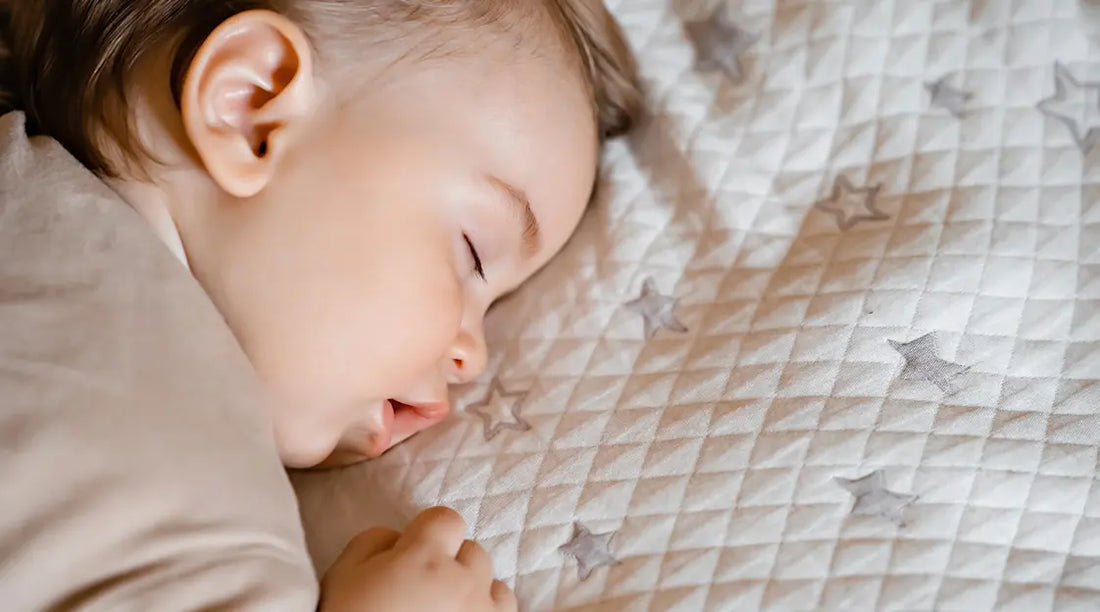
When Can Toddlers Sleep With a Blanket?
공유하다
Are you wondering, "When can my baby sleep with a blanket?" If you're wondering when a baby can sleep with a blanket, there is no official, universally accepted age for when a blanket can be used in a child's bed or crib. However, most experts agree that children should be allowed to use blankets until they are at least 12 months old, but ideally 18 months or older. This is for various safety reasons.
Adding a blanket or other soft bedding too early, either at night or during naps, can be dangerous, so the safest thing to do is to wait until your baby is old enough to handle a blanket. Here's a breakdown of the risks of blankets, as well as when you can try using one and how to keep your baby warm before you do so.
Is it safe for babies to sleep with a blanket?
No, blankets in cribs can be dangerous. Approximately 3,600 babies die unexpectedly in their sleep each year in the United States, usually from causes related to sudden infant death syndrome (SIDS), suffocation, entrapment, or strangulation, and baby blankets can increase the risk of all four.
Babies move around a lot in their cribs at night, so baby blankets or any loose items can block their delicate airways. Babies lack the strength to move away from danger or obstacles on their own, which increases the risk of suffocation. So the safest sleeping environment is an empty crib, completely free of quilts, bumpers, pillows, wool blankets, sheepskins, and stuffed toys. In fact, the only thing your baby needs at night is a sheet tucked in tightly on all four sides.
When can your baby sleep with a blanket?
According to the American Academy of Pediatrics (AAP), there is no official age at which it is 100% safe to use a blanket, quilt, or comforter, but most medical experts believe that soft bedding in the crib poses little risk to healthy babies over 12 months old, and ideally 18 months or older.
So it's best to wait until your baby is at least 18 months old before covering her with a blanket at night or during naps, because babies can still get entangled in blankets when they are young. After 18 months, thin blankets and small, special “heart toys” are ready to tuck in and may even become an integral part of your baby’s tuck-in process.
Remember, even if you intend to place your baby on top of a blanket instead of underneath, you should avoid using soft bedding. This is because the blankets could tangle up in your baby's sleep space or become stuck in the crib's corners at night.
If you decide to add a blanket or comfort item to your baby’s sleep space, it’s recommended that you wait until your baby is at least 18 months old. When adding a baby blanket, always choose a thin, breathable blanket, such as one made from bamboo fabric. If your baby starts playing with special toys or stuffed animals in his or her bed, try to encourage the addition of something small, rather than a giant teddy bear that doubles as a pillow! Occasionally, a few small comfort items or “heart toys” can help older toddlers and preschoolers feel more comfortable at bedtime, especially if they need more time to wind down before falling asleep. These little bedtime supports are usually fine unless it’s clear that your child has been playing with the item rather than using it to wind down and fall asleep.
How to Swaddle a Baby Until They Fall Asleep
To swaddle your baby properly, choose a thin, lightweight bamboo baby swaddle blanket. The blanket should be slightly loose around your baby's legs, but your baby's arms should be tight and straight, with a few fingers' worth of space between the blanket and your baby's chest. A swaddle that's too tight can restrict breathing, or one that's too loose can cause your baby to fall apart, both of which can put your baby at risk.
Swaddling a newborn at night is perfectly fine and is actually recommended to help fussy babies settle down to sleep.
A properly swaddled baby swaddle or baby sleeping bag is safe to use from birth until your baby starts trying to roll over (around 3 to 4 months, sometimes earlier). Don't place a second blanket over a swaddled baby, as this loose bedding can cover your baby's face, increasing the risk of suffocation.
Is swaddling your baby safer than using a loose blanket?
 Swaddling your baby is much safer than covering him with a loose blanket. Swaddling your baby properly , without loose parts, or using one of our baby sleeping bags will prevent the blanket from blocking your baby's breathing and posing a safety hazard. Swaddling not only keeps your baby warm but also comes in a variety of safe designs for all climates.
Swaddling your baby is much safer than covering him with a loose blanket. Swaddling your baby properly , without loose parts, or using one of our baby sleeping bags will prevent the blanket from blocking your baby's breathing and posing a safety hazard. Swaddling not only keeps your baby warm but also comes in a variety of safe designs for all climates.
How do I keep my baby warm without a blanket?
It's perfectly fine for babies to sleep without a blanket, so if your baby is less than 12 to 18 months old, you can keep her cozy by putting her in a sleeping bag or onesie. These onesie pajamas have zippers that cover your baby's body but not her head.
Keep in mind, though, that if your home or baby's room is hot, she may not need this extra layer of clothing. The ideal temperature for a good night's sleep is between 68 and 72 degrees Fahrenheit, regardless of the season. Turning up the thermostat and wrapping your baby too thick can cause your baby to overheat, increasing the risk of sudden infant death syndrome (SIDS).
Try feeling the back of your baby's neck to determine if she's warm enough at night. If her skin feels cool to the touch, she needs another layer; if she feels hot or sweaty, she's too hot. Your comfort level is also a good way to tell if the weight of your baby's sleepwear is the right weight. If you feel cold under the covers, she probably does, too.
What should you look out for after you cover your baby with a blanket?
Once your baby is 18 months old, you can try using a baby blanket. The first step is to choose the right blanket.
Choosing the Right Blanket
Miozing is your one-stop wholesale shop for everything you need for babies and kids. We have everything you need for baby romper, kids' sleepwear, newborn accessories, bamboo blankets, and more! Come check out our range of baby blankets and see for yourself—you'll love our designs.
Whether you're looking to buy baby blankets wholesale. Whether you want to customize baby clothing or buy in bulk, Miozing has you covered! Take a look at our most popular styles!
Introduce blankets gradually with supervision.
First, while your child is awake and under supervision, place the baby blanket over them to help them acclimate to its texture and weight. This step helps prevent your child from feeling overwhelmed or uncomfortable when they first start using the blanket during sleep. If you don’t notice anything unusual, then you can consider incorporating the blanket into your baby’s bedtime routine.
Check on your child throughout the night.
The first few nights of having your child sleep with a blanket can be stressful. You may even have trouble falling asleep if your child is unsupervised in the nursery. So, get up frequently to check on them. After all, you'll be able to sleep easy knowing they're safe.
If your child seems uncomfortable or just isn’t sleeping well, you may need to adjust the blanket. Consider the type of bedding used and whether the blanket is too warm or fussy for them. This shouldn’t be a problem if you stick with miozing baby products.
Baby bedding rules may seem complicated at first, but these guidelines are designed with safety in mind. If your child is old enough to use a blanket, add an extra one, or skip the blanket altogether and use a sleeping bag. Either way, she'll stay warm all night long.
